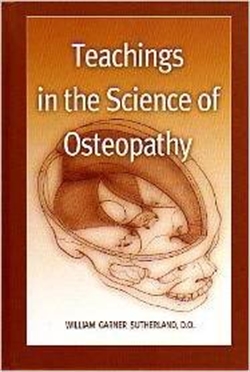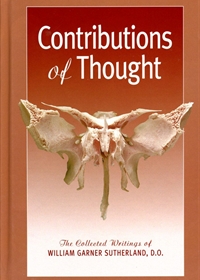
Teachings in the Science of Osteopathy

Autor:
William Garner Sutherland

Dr. William Garner Sutherland
William Garner Sutherland byl americký osteopat a významná osobnost v americké osteopatické medicíně. Sutherland byl první osteopat, který přišel s konceptem kraniálního přístupu a systematicky ho vyučoval, i když on sám považoval A.T. Stilla za vynlázece veškeré osteopatie, vč. kraniálního přístupu. Sutherland byl prvním člověkem, který popsal rytmické změny tvarů kostí a lebky (krania). Později tento rytmický pohyb aplikoval i na ostatní tkáně v těle a považoval tento pohyb za původce změn v nemocných tkáních. Později nazval tento pohyb Primární respirací.
více o autorovi►William Garner Sutherland had the opportunity to study with Dr. Andrew Taylor Still, the founder of the science of osteopathy. In his teaching, Dr. Still always emphasized the design for motion in the articulations of the bones.
One day in 1899, during Sutherland's senior year at the American School of Osteopathy, he viewed a specially prepared and mounted skull. At that moment, Sutherland experienced a flash of insight which saw the articulation of the sphenosquamous suture as a design for motion that implied a respiratory mechanism, "like the gills of a fish." Given the statements in anatomical texts that the sutures of the cranium ossify in the adult, he had much skepticism and reservation about his own insight for years. During his in-depth studies in the following years, Dr. Sutherland had to confront the fact of a mobility that has no muscular agencies to account for the motion.
Belatedly rallying to his support, a group of his colleagues felt impelled to correlate all the information available on the subject in textbook form. This is the third edition.
This kind of study of the mechanics of articular mechanisms in the living human body led him to recognize powers within his patients which could resolve problems and heal strains. Based on what he learned from his patients, Dr. Sutherland developed many ways of practicing osteopathy. He considered that he was utilizing a profound science which just kept unfolding its truths. Dr. Sutherland often said in his lectures that if you understand the mechanism, the treatment is simple.
One day in 1899, during Sutherland's senior year at the American School of Osteopathy, he viewed a specially prepared and mounted skull. At that moment, Sutherland experienced a flash of insight which saw the articulation of the sphenosquamous suture as a design for motion that implied a respiratory mechanism, "like the gills of a fish." Given the statements in anatomical texts that the sutures of the cranium ossify in the adult, he had much skepticism and reservation about his own insight for years. During his in-depth studies in the following years, Dr. Sutherland had to confront the fact of a mobility that has no muscular agencies to account for the motion.
Belatedly rallying to his support, a group of his colleagues felt impelled to correlate all the information available on the subject in textbook form. This is the third edition.
This kind of study of the mechanics of articular mechanisms in the living human body led him to recognize powers within his patients which could resolve problems and heal strains. Based on what he learned from his patients, Dr. Sutherland developed many ways of practicing osteopathy. He considered that he was utilizing a profound science which just kept unfolding its truths. Dr. Sutherland often said in his lectures that if you understand the mechanism, the treatment is simple.
webová stránka:
ISBN:
978-1930298002
sdíletDalší knihy autora
Contributions of Thought

William Garner Sutherland came to study the osteopathy of Dr. Andrew Taylor Still in 1898 and found within...